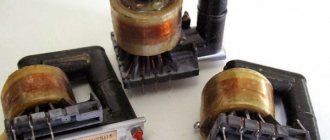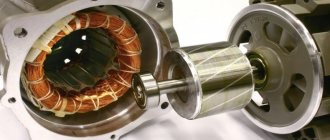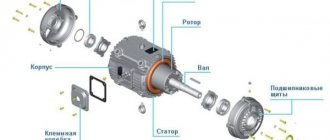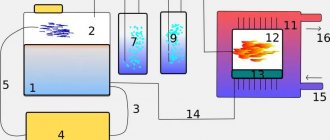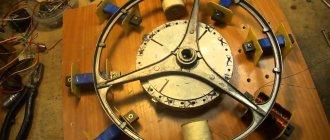Register Login
Publication date: November 6, 2019
The beginning of the 20th century confronted scientists with the need to look for ways to obtain and accumulate huge amounts of electrical energy, sufficient to run massive machines and mechanisms. History has preserved information about numerous studies and scientific developments, some of which were frankly unsuccessful, while others, on the contrary, made us talk about themselves from the point of view of scientific and practical interest. Among the latter are the works of Robert Van de Graaff, who created an electrostatic generator with a unique design. Several million volts of electrical energy is more than enough, especially since we are talking about the 30s of the last century, when the world was shaken by loud military and revolutionary cataclysms that hindered the development of science. For some time the inventor reaped the benefits of his fame, and his generator found wide use as a linear accelerator. But after a short time, the bulky device was replaced by more compact and powerful models, relegating its prototype to the background of history and practical physics.
Later, Van de Graaff's invention was named after him and even found its modest practical application - demonstrating experiments on particle acceleration and energy storage. And the foundations laid by the inventor were used as a basis for improving accelerators for the purpose of their practical application.
History of creation
American physicist Robert Van de Graaff (1901-1967), who worked at Princeton University, went down in history as the creator of the electrostatic particle accelerator.
The first description of a Van de Graaff generator was made in 1929, and two years later he created a high-voltage accelerator that could produce an electrical voltage of 1 MV. In 1935, the improved design already produced 7 megavolts.
The Van de Graaff generator later became the basis for a modern type of linear accelerator called a pelletron. The difference between them was the method of transmitting charged particles. If in the generator they were transmitted using a dielectric tape, then in the pelletron they were transmitted by a metal chain.
In the early 1930s, Dr. Robert Van de Graaff, who at that time was working as a research fellow at the Massachusetts Institute of Technology and was engaged in scientific research in the field of nuclear physics and accelerator technology, developed, designed and soon built a high-voltage electrostatic accelerator operating on the principle of electrified conveyor belt air ions (1933).
Later, in 1936, Van de Graaff built (all on the same principle) the world's largest electrostatic constant voltage generator - the Van de Graaff tandem generator, consisting of two high towers.
Newspapers of that time called the assistant professor’s invention nothing less than revolutionary and predicted that he would “perform miracles” and “unlock the secrets of nature.” Such a strong stir in the press is not at all surprising, because the largest two-stage Van de Graaff generator consisted of two huge columns with a diameter of almost 2 meters each and a height of approximately 15 meters (with metal spheres with a diameter of 4.5 meters fixed on top of the columns, inside which mechanically supplied an electric charge) and made it possible to obtain a potential difference of 7,000,000 volts.
Despite the low efficiency of the device as a whole (about 23%), people who saw the wonderful device in operation experienced an indelible impression, because the spark discharges were more than a meter long.
The power of the Van de Graaff generator was enough for real research work - to accelerate atomic nuclei, as well as elementary particles such as protons and electrons, to fairly high speeds. Thus, the Van de Graaff generator, used in accelerators, helped scientists identify the constituent parts of atoms that represent the structure of the physical universe.
They say that the idea for the operating principle of a high-voltage generator came to Van de Graaf when he was still a student and observed sparks of static electricity every now and then on a working printing press.
The principle of operation of the generator is as follows. The silk or rubber tape (dielectric tape) is stretched and rotated like a conveyor belt on a pair of rollers, one located at the base of the column, the second inside the cavity of the conducting sphere at the top. The lower roller is made of metal and galvanically connected to the ground; it is driven by a motor. The upper roller is dielectric.
A metal brush is connected to the tape from below, under the lower roller, with a small gap, connected to the positive terminal of a high voltage source, the negative terminal of which is connected directly to the lower roller.
So, a dielectric tape moves between the lower roller and the brush (in the real generator the tape was about 120 cm wide). Under the influence of high voltage (about 20,000 volts) between the roller and the brush, the air between them is ionized and positive air ions, attracted by the Coulomb force, rush to the negatively charged roller. But since there is a dielectric tape in the path of the ions, the ions settle on the tape, thus charging it.
The tape moves from bottom to top, at the bottom it continuously receives a charge, at the same time, a charge is continuously taken from its surface near the top roller, since the top roller inside the sphere also has a brush located next to it. The brush removes the charge from the tape, and being galvanically connected to the inner surface of the hollow conducting sphere, transfers the charge to it, increasingly electrifying this spherical capacity over its entire outer surface, essentially pumping charge into it.
The fundamental possibility of accumulating charge in the capacitance of the Van de Graaff generator sphere is limited by a corona discharge, which will inevitably arise due to the ionization of the air surrounding the sphere. The theoretical limit for a 4.5 meter diameter sphere is approximately 17,000,000 volts.
American scientist James Stuckey and volunteer Judy Creeden demonstrate the human body's ability to conduct electric current. Lecture in New York, 1966
Earlier, ElektroVesti wrote that a generator for ships was invented that converts exhaust into electricity.
Based on materials from electrik.info.
Operating principle
The design of the generator allows it to be made both horizontally and vertically. Its main part is a large metal sphere, on the surface of which charged particles accumulate. Inside the housing made of insulated material there are two rollers connected to each other by dielectric tape. It was originally made of silk and rubber, and was later replaced by a chain.
The lower roller is grounded and connected to the small sphere, and it also has a drive for rotation. The upper roller is connected to a large sphere through a metal brush.
As the lower roller rotates, the air ionizes, followed by the transfer of charged particles to the upper roller. Through a metal brush, a stream of ions is transferred to the surface of a large sphere, where it accumulates in the form of an electrostatic charge.
The power of the Van de Graaff generator is limited by the corona discharge, which creates a luminous shell around the charged electrode.
Design and principle of operation
The generator design can be vertical or horizontal. The most common is a vertical installation. This generator includes:
- an endless dielectric rubber or silk tape moving at a speed of 20-40 m/s on 2 rotating pulleys;
- 2 pulleys. The lower pulley is made of metal and is rotated by an electric motor, and the upper pulley is made of a dielectric, such as acrylic glass;
- a hollow metal electrode in the form of a hemisphere, inside of which there is an upper pulley. This electrode is mounted on an insulator;
- high voltage source.
The lower pulley is grounded. A high voltage is applied to the electrode located near this pulley. Electrodes made in the form of a brush or comb are installed at a short distance from the upper and lower pulleys. The upper electrode is connected to a hollow hemisphere.
Where is the generator used?
Initially, the device was used to accelerate charged particles, but over time, more advanced accelerators appeared, and the need for it disappeared. Currently, experiments with a Van de Graaff generator are carried out mainly to simulate the processes occurring during lightning discharges.
In modern schools, this device is standard equipment in physical classrooms. The generator was not produced in the territory of the former USSR. In schools, Wimshurst's electrophoric machine was used for experiments, which was later called “Discharge”.
The ability of the generator to produce discharges is used in various show programs and circus tricks. It can create a field that holds small objects in the air, and a powerful charge allows electrical devices to operate far from a source of electricity.
Children's tricks
Do you want to create “magic”? Take a plastic bag, cut both ends and tie with a string to make a bow. Then rub a regular plastic ruler well on a woolen item and bring it to the bow: the flight will begin...
You can buy a ready-made “magic wand” with figures with which you can do such tricks in a store.
But the easiest way to see the “magic” is to simply pet the cat. Then you can both feel and see the static electricity that arises.
But the toy, which follows the design of the Van de Graaff generator, runs on a rechargeable battery. When the button is pressed, an electrostatic charge is created at the tip. Therefore, the figure adopts it, and charges of the same name begin to repel each other. Since the figure is cut in a certain way, it “inflates” and gains volume. If the charge weakens, then you just need to press the “magic” button again.
Precautionary measures
Like any device that produces high voltage, the Van de Graaff generator requires precautions when working with it. The discharge does not matter where it occurs: between oppositely polarized electrodes or between a charged electrode and the human body. A significant difference in potential is enough. Therefore, when working with a generator, a person must be on a rubber mat so that its potential remains neutral with respect to the accumulated charge.
If a person is on the floor, especially on a damp one, then he will become an excellent conductor for transmitting charged particles to the ground, and a discharge of several thousand, and maybe millions of volts will pass through his body. The only thing that can allow a person to stay alive is a low current strength.
People with pacemakers should not approach the generator. Electronic devices such as watches and cell phones may malfunction. Therefore, before starting experiments, you need to leave them aside.
What you need to assemble the device yourself
The model is easy to build yourself using available materials. The Van de Graaff generator, assembled with your own hands, consists of the following components:
- pencil;
- cutting PVC pipe;
- elastic bands;
- paper clips;
- aluminum foil;
- engine from a toy;
- non-working light bulb;
- dry pastes from a pen;
- nine volt batteries;
- tape;
- wires;
- planks.
All elements must be dry, as well as the air in the room. Otherwise, the design simply will not work, or it will work, but very weakly.
This is what a Van de Graaff generator will look like. The photo below shows what the model should look like.
Before starting work
Generator elements, such as belts, pulleys, and a sphere, attract dust to themselves like a magnet. Before starting work, you need to clean the mechanisms. To do this, you need to remove the large sphere and wipe the parts of the device with a damp cloth. If the accumulated charge does not allow you to get rid of dust, then you can use an antistatic hair spray.
The most important thing to do before starting to rotate the generator is to make sure that the small electrode is grounded. Otherwise, the discharge will hit an object with a larger mass, that is, a person.
How to assemble a generator at home
Now that the operating principle of the Van de Graaff generator is known, you can independently assemble a working model for home experiments. After some testing, it turned out that PVC pipe for water supply is best suited for producing charged particles. If you rub it with a synthetic material, the charge that appears in it will allow you to attract small pieces of paper and deflect the stream of water falling down. Therefore, the PVC pipe will become a source of charged particles.
What will transfer electrons to the generator sphere? Experiments have shown that a Martens medical bandage is best suited. It is composed of polyester, latex and cotton fabric.
Now that we have decided on the main working parts, a complete list of necessary materials is compiled:
- Large metal sphere. It is made from two large salad bowls, sold in the nearest hypermarket.
- PVC pipe. You will need 2 pieces of different diameters. The first will become the generator housing, and the second must be selected in such a way that it fits tightly onto the pulley connected to the drive.
- Upper pulley. You can use any suitable object to hold the tape without coming off. For example, an old bicycle wheel hub or a large plastic spool with sides.
- A piece of copper stranded wire. Brushes will be made from it that remove and transmit the charge.
- Low-power electric motor. Required to rotate the lower pulley. However, if desired, the drive can be made manually.
- Metal strips for supporting the generator, as well as for fixing the pulleys on the PVC pipe.
- Metal ladle. It will act as a small electrode.
Do-it-yourself Van de Graaff generator assembly
When all materials are prepared, you can begin manufacturing:
- Make a rectangular base for the generator from metal strips. It must be done in the shape of a square. The dimensions must ensure the stability of the structure. It is also necessary to provide mounting for the electric motor.
- Attach the lower pulley to the motor shaft. Its working surface should be covered with a piece of PVC pipe, which is cut to the width of the Martens bandage.
- Attach the electric motor to the platform so that the pulley is in its center.
- Attach a PVC pipe with a diameter of 150 mm in a vertical position above the pulley. Its length should be 50-60 cm. To make it easy to remove and put on the tape, you need to make an axial cutout 4-5 cm wide on the pipe.
- A second pulley must be installed on the top of the vertical pipe. This is done using fastening brackets.
- Make a sphere from salad bowls. To do this, cut a hole in one of them in the lower part exactly according to the diameter of the pipe. To the same salad bowl around the perimeter you need to solder several staples that will hold the second half.
- Make a brush from stranded wire. To do this, remove the insulation on a length of 2-3 cm and separate the bundle into separate wires. One end of the brush must be secured so that it touches the upper pulley, and the other end must be soldered to the sphere.
- To make an electrode from a ladle, you need to connect the handle to the metal base of the generator and ground it. The handle must be insulated. The same PVC pipe of small diameter is suitable for this.
The prototypes of the Van de Graaff generator in the photo taken a hundred years ago differ little from the device made by hand. Now that the device is completely ready, you can begin the experiments.




